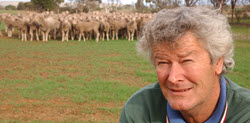Next generation genetics

The Michael family from Leahcim Poll Merino and White Suffolk studs at Snowtown, Burra and Willooka in South Australia were early adopters of both genetic and genomic technologies and are constantly pushing the boundaries of the technologies’ capabilities.
Andrew Michael has been collecting flock data for his own selection purposes and to generate Australian Sheep Breeding Values (ASBVs) for more than 30 years.
“Without ASBVs, genomics and the MLA Resource Flock, there is no way we could achieve what we’re doing now,” Andrew said.
Here we take a closer look at three genetic technologies helping them speed up the progress of traits in their Poll Merino and White Suffolk ewe flocks.
1. JIVET
In the past three years, the Michaels have dramatically sped up the process of genetic gain in their stud sheep using DNA testing and juvenile in vitro embryo transfer (JIVET).
In 2007, Andrew began using JIVET to speed up the rate of genetic gain in his Poll Merinos.
The JIVET process involves identifying superior breeding stock at an early age, using advanced embryo technology to collect eggs from ewe lambs when they are six to eight weeks old, fertilising eggs in a test tube with semen from the most advanced performance rams and transferring them to surrogate mothers.
The result is a new drop of high-performance lambs in six-and-a-half months, rather than two years using traditional breeding methods.
The Michaels’ initial program of genomics-based JIVET was in 2013.
As well as achieving breeding objectives, Andrew said the JIVET process helps identify negative breeding outcomes much earlier.
“We undertook a JIVET program that included three outside sires that had high fleece weights, but had skins that were different to ours,” he said.
“In three generations with JIVET – 20 months – we couldn’t get the skin and follicle structure that was acceptable to us and our clients, with no sires being retained for future breeding purposes.”
2. DNA testing
As well as speeding up gain in traits such as growth, fat, muscling and wool production, DNA testing has allowed them to select for hard-to-measure eating quality traits.
“When we started, we were just using pedigrees to determine superior stock and really guessing the rest. Once full DNA testing became available, the potential took off,” Andrew said.
It means the Michaels now have the consumer firmly in mind.
“Our selection pressure for eating quality in both Merinos and White Suffolks are enormous – it has become a very high priority for us,” Andrew said.
3. Measuring additional traits
It’s not just about meat and wool; benefits have also flowed in the form of higher skin prices and improved animal welfare.
“We have increased our measuring and selecting for follicle density, which doesn’t have an ASBV but which I believe is the best way to increase fleece weight without increasing skin wrinkle,” Andrew said.
“Because of this work – plus past work to improve skin in both Merinos and White Suffolks – the skin component of our sheep at slaughter is much more valuable.
“Last year we put a couple of thousand lambs through our feedlot and sold them over the hooks, averaging about $12 per skin on the British breeds and $22 for the Merino skins.
“As well as increasing skin value, genetic selection has allowed us to improve animal welfare outcomes and reduce chemical use on our farm: we haven’t mulesed since 2004 and we haven’t backlined for bodystrike for 30 years.”
Information
Andrew Michael
E: leahcimgenetics@bigpond.com
T: 08 8865 2085
Resources: www.sheepgenetics.org.au



